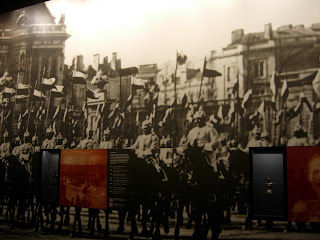We woke up to another misty, cloudy day here on the Missouri/Kansas line. We have a list of things to see here but many of them are closed on Sunday so we opted for the National World War I Museum. Ray and Linda joined us on this tour. This is a beautiful museum, with three floors of exhibits. I spoke with one of the volunteers and he said they change out the exhibits on the 3rd floor every 3 months because they have so many. I asked him why Kansas City had this memorial and he told me that this city had suffered more losses in this war than any other city of its size (it was a very small town at the time). He added that a lot of cities had built memorials after the war but most of them not survived the depression, and so their exhibits were sent here. Then, when it was declared a "national" memorial, more exhibits poured in, so their have an extensive collection. He told me that only 9% of their collection was on display at any one time, and that is why they change them out every three months.
First you cross a glass bridge that spans a field of 9,000 poppies (artificial), each representing 1,000 combatant deaths during WWI. The most famous poem to emerge from WWI was "In Flanders Fields" (1915). Here's the first 2 lines of that poem: "In Flanders fields the poppies blow, Between the crosses, row on row." Its first lines guaranteed that the poppy became the flower of remembrance for that great conflict. My picture was shot through the glass floor and didn't turn out very clear.
The tour starts with a 12-minute video that offers insight into world events that led to the war . Then we entered into the exhibit hall and were met with these huge Portrait Walls that almost overpower you. We wandered on through the various displays -- lots to read, starting with a monthly account before America entered the war. A second video depicts America on the threshold of war and what led to the decision to enter the war.
Of course, many of the weapons from that war were on display,
including a torpedo and a land mine.
Also displayed were a team of horses pulling artillery, a Ford vehicle used for transporting men and supplies, and a small plane.
We had an excellent lunch in the museum cafe, then went outside and took the elevator to the top of the 217-foot Tower. We had great views of the city from there, but it was a bit chilly.
Ray and Linda had to assume their camp hosting duties at 3:00 so we headed back to the park and dropped them off, then got to watch the last 62 laps of the rain-delayed NASCAR race. I really thought my guy was going to win this one (he would have if they had called the race then), but he ended up third.
We have a small family of geese that saunter through the campground between the lake and our RV every morning, the parents and 4 babies. But when they heard me coming, they took to the water.
This is one of the prettiest campgrounds we have ever stayed in, and we are right on the water. Joe keeps trying to figure out how to get our boat here. We've seen a couple fish jump, there was a sailboat out here when we got back today and we've seen some fishing boats pass by, and some guys had fishing poles out just down from us, but we don't know if they had any luck. If the sun comes out, we may never leave here.
Our plan is to leave here on Wednesday, heading into Daniel Boone territory. We are assuming we will be able to cross the Mississippi River at St. Louis, so I hope it doesn't rain any more back there.




















That's a really beautiful memorial, and one limestone monument I didn't know about. Here's the tower at night http://bit.ly/ZBN7da - or what you'd see if the clouds ever moved out of the way! - Cathy
ReplyDeleteLet me try that again...
ReplyDeleteTower at night
very nice. We haven't ventured into the city in the dark yet, and probably won't, so we won't get to see that.
ReplyDelete